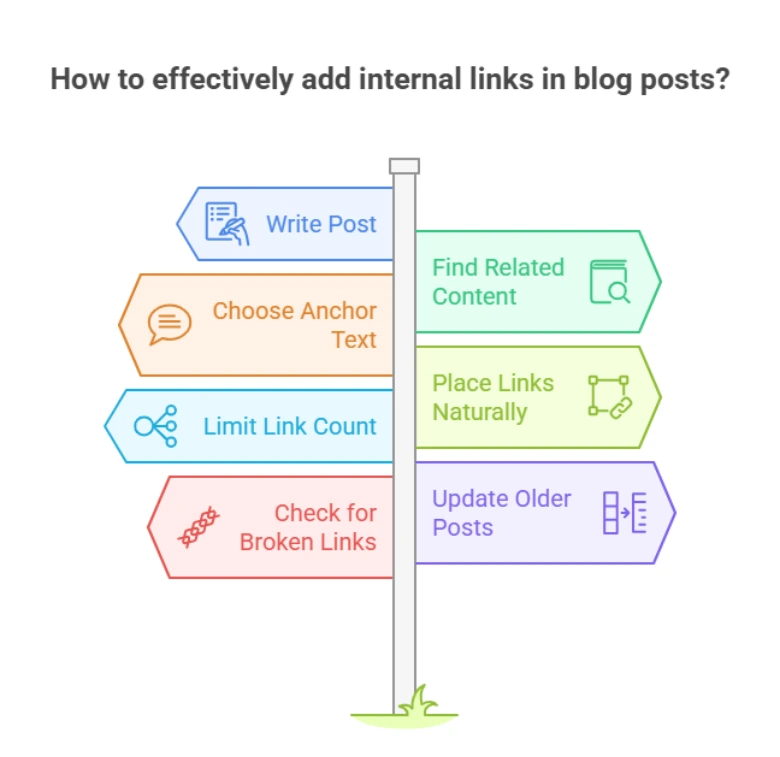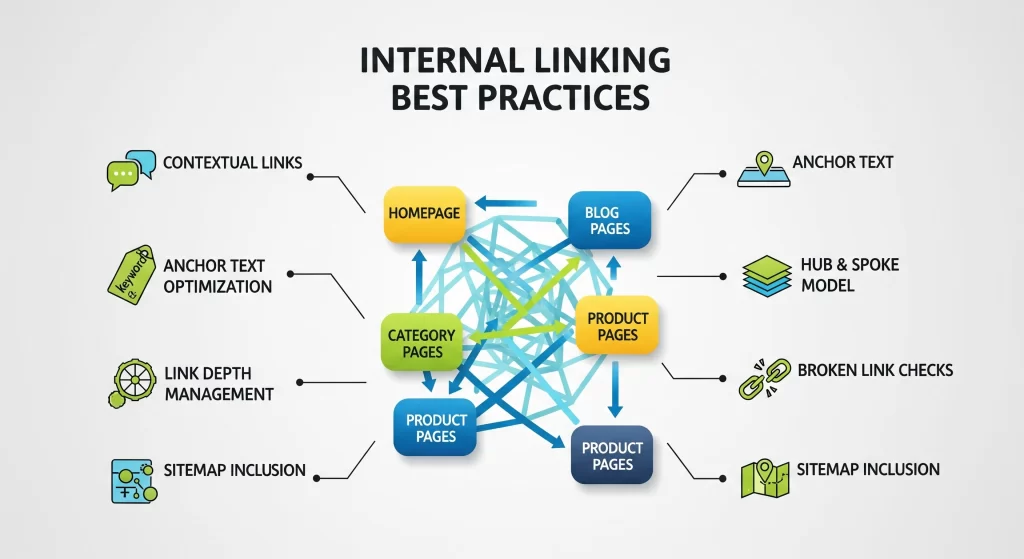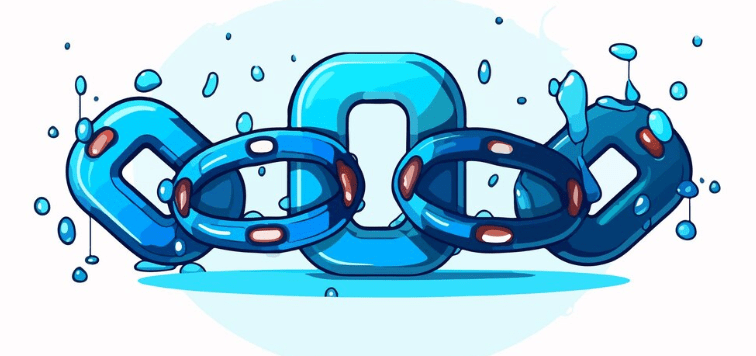When you enter a library, you take a book of your interest and start reading it. Imagine what if in that book, you find a reference of another book, explaining some other aspect of the same topic. It would be really helpful, right?
Well, you can do the same for your website visitors by adding links to your other related blog posts within one article. This is called internal linking. It helps visitors (and search engines like Google) easily discover and explore more connected content.
Using the right pathways, your website becomes easier to navigate, and Google can make sense of what matters most. These internal linking best practices guide both people and search engines to your best content.
Why Internal Linking Matters
Most SEOs believe that there should be 2 to 3 internal links in a blog and there are many good reasons behind that, like:
A. Helps Google and Visitors Find Your Content
- Internal links act like signposts, helping search engines discover and index new pages faster. A good internal link from a popular page makes a new page easier to find.
- Readers stay longer if they can click to related content instead of leaving in search of more.
B. Shares the Goodness (Link Equity)
- Think of your homepage or popular posts as “authority hubs.” When you link from them to other pages, you pass along some of their Google-friendly values, called link equity.
C. Organizes Your Site Clearly
- A smart pyramid-like structure helps Google understand which pages are top-tier (like your home page), and which are deeper content.
Using a hub-and-spoke or topic cluster model means one main article (hub or pillar) links to related articles (spokes), clearly showing their connection.
Simple Best Practices for Easy Navigation
1. Use Descriptive Anchor Text, Not “Click Here”
- Anchor text is the link text people click. Instead of “click here,” say exactly what the link leads to, like “learn how to write SEO titles.” This helps both humans and Google.
2. Keep Links Contextual, Not Overloaded
- Put internal links where they fit naturally, in the main content, not stuffed in footers or sidebars.
- Avoid overwhelming readers with too many links. A good general rule is around 2 to 5 links per 1,000 words.
3. Mix Up Anchor Text, Don’t Repeat
- Don’t link using the exact same phrase over and over. Make changes to your anchor text to look more natural for readers and for SEO.
4. Link to Your Most Important Pages
- Focus internal links on high-value, cornerstone content, the pages you most want to be found. That way, they gain more link equity and get more visibility.
5. Avoid Orphan Pages
- Orphan pages are those that no other page on your site links to. They’re hard for people and search engines to find. Make sure every page has at least one incoming link.
6. Link From Popular Pages to New Ones
- Got a brand-new post? Add internal links to it from older, top-performing posts. That’ll help Google discover and rank your new content faster.
7. Fix Broken Links Regularly
- Broken links are frustrating for readers and can hurt your SEO reputation. Routinely check and fix the broken links.
Internal Linking Best Practices SEO for Everyone (Even Beginners!)
Now, the term internal linking SEO might seem something out of syllabus, but don’t worry, all this just means doing internal linking in a smart, reader- and Google-friendly way.
Step-by-Step How to Add Internal Links in Blog Posts

Graphic 1.1. Infographic on steps to add internal links in blog posts
It is a simple process in the SEO internal linking best practices, which when you master, no one can stop you.
Step 1: Write Your Post
The centre of attention should be the main idea. You’ll love this example, if you’re into gardening, say you’re writing “How to Plant a Vegetable Garden.” That’s your new post.
Step 2: Find Related Content
Look for older articles like “Picking the Right Seeds,” “How to Water New Plants,” or “Composting for Beginners.”
Step 3: Choose Good Anchor Text
Instead of writing “click here,” link phrases like “choose the right seeds” or “watering your new vegetables.”
Step 4: Place the Links Naturally
Add links where they make sense, for example, “Before planting seeds, learn how to choose the right seeds for your climate.”
Step 5: Use No More Than a Few Links in the Main Post
Follow the 2 to 5 links per 1,000 words rule to keep things readable.
Step 6: From Older Posts to New One
Update those older posts with links like “Also check out our guide on how to plant a vegetable garden” pointing to your new post.
Step 7: Check for Broken Links
Use a link checker plugin or tool to find and fix any broken links on both new and older posts.
Fancy but Not Too Fancy Tips to Level Up
In this internal linking best practices guide, we’ve mentioned some tips that will help you in internal linking.
Use Plugins (Especially on WordPress)
- Yoast SEO Premium suggests internal links as you write.
- Tools like Link Whisper offer automatic suggestions and tracking
Keep It Natural for AI and Voice Search
- Use conversational language in links, think like someone asking: “how to water new plants” instead of stiff keywords.
Make Sure Site Structure Supports Linking
- Think of your site as a pyramid: homepage → categories → detailed posts.
- Keep important content within two clicks from the homepage for better visibility.
Use Both Contextual and Navigation Links
- Contextual links are inside your article.
- Navigation links include menus, sidebars, or breadcrumbs, helping users find pages quickly.
Common Pitfalls (What to Avoid)
- Too many exact-match anchors, repeating the same keyword link everywhere looks spammy.
- Vague anchor text like “click here” gives no context.
- Broken or expired links are a big no no. They frustrate readers and can hurt SERP performance.
- Leaving orphan pages makes them hard to find and less valuable.
- Ignoring structure? Please don’t! Without a clear linking plan, your site may feel disorganized to both people and search engines. This is one of the most important part of the best practices for internal linking.
What are the best practices for internal linking in blog posts? (Quick Checklist)
Link to related and helpful pages.
Use clear, descriptive anchor text (no “click here”).
Mix up your anchor text.
Stick to a few links within main content.
Link to or from cornerstone or popular posts.
Make sure every page gets at least one link.
Regularly hunt and fix broken links.
Use tools or plugins to help if needed.
Structure your site like a pyramid or topic cluster.
Keep links natural and easy for voice or AI-based search.
Final Thoughts: Bringing It All Together
Internal linking isn’t just adding links in your blog that take people to other pages on your site, it’s a major ranking factor. It’s like giving readers a quick path to more helpful stuff. Google also uses these links to see which pages are most important. By doing it the right way, you make your site easy to explore, good for SEO, and friendly for visitors.
Whether you’re new to SEO or refining your blog strategy, these steps, using internal linking SEO best practices, make your content more discoverable, organized, and reader-friendly.
Happy linking, and may your site shine in both visitor hearts and search rankings!
If you’re looking for SEO services or complete digital marketing services so you can focus on the main hustle, we’re here for you. At Wildnet, we understand the ins and outs of SEO and have helped 4100+ brands achieve not-so-possible rankings(in a good way). So, why wait? Connect now!
FAQs
What is an internal link?
An internal link is basically a link that takes you to some other page of the website. This is like a shortcut pathway that helps the visitors explore more information you’ve posted on your site relating to that particular topic or services pages. From readers to Google, this acts as a signal of you holding an expertise in that topic.
Why are internal links so important for SEO?
Simple, these internal links are very helpful to search engines in crawling, indexing, and understanding your site’s hierarchy and content relationships. They allow you to shape your site structure, signal priority content, and distribute ranking power (link equity) from high-authority pages to newer or less visible ones.
How are internal and external links two different things?
Internal links keep readers within your domain, enriching navigation and aiding SEO. External links take your users away from your site, helpful for credibility, but less useful for keeping traffic and sending ranking signals internally.
What makes for a ‘good’ anchor text in internal links?
Effective anchor text should be descriptive, keyword-rich, and contextually relevant. Think “best vegan pasta recipes” instead of “click here.” This aids both users and search engines to understand the main essence of the linked page and avoids over-optimization penalties.
Is there an optimal number of internal links per page?
There’s no hard cap. Focus on relevance and user benefit over quantity. Some marketers recommend at least three internal links while avoiding spammy link placement.
What are orphan pages and why are they bad?
Orphan pages are standalone content with no internal links pointing to them. They’re poorly indexed, often overlooked in SEO, and hard for users to find. Linking to these pages is critical so they gain visibility and authority.
How can I strategically link cornerstone content?
A cornerstone page is your main, most detailed page on an important topic. You should link to it from all other related pages, and also add links from it to those pages. This creates a clear connection between them, making it easy for visitors and Google to see it’s your “main” page on that subject.
How do internal links influence crawlability and site architecture?
Search engines use internal links like roads to move around your site. If your links are well-planned, Google can find and load your pages faster, without wasting time, even for new or hidden pages.
Can internal linking best practices help increase conversions?
Yes! Internal links can lead visitors from a blog post to a product page or a sign-up page. This smooth navigation can significantly influence user behavior and conversions.
Read More:







